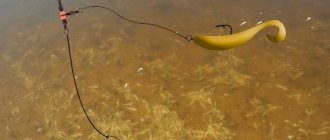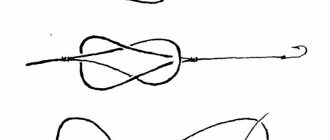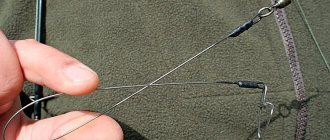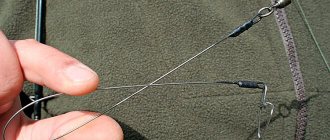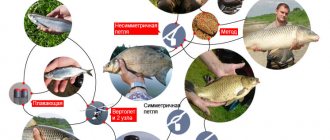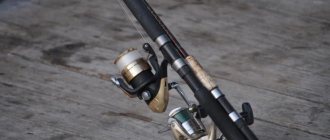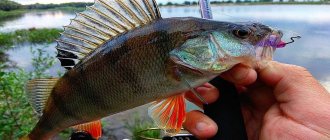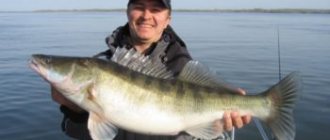Yuri 09.24.2020 359
Fishing is an exciting activity that enjoys well-deserved popularity. A huge range of accessories and devices are used in the fishing process. One of the important elements of fishing equipment is a leash. This accessory ensures reliable fishing and its high efficiency. Therefore, the choice of leash should be approached wisely. The size of the gear must be taken into account; the material from which it is made; individual characteristics of the reservoir; as well as the type of fish.
Drive materials
Leashes
Not only a beginner, but even an experienced angler can easily get lost in the modern variety of leashes. Dozens of brands offer their products from various materials, with guidelines both for a specific predator and for the type of bait used in fishing. At the same time, homemade metal leashes have not lost their relevance.
Fluorocarbon leaders
Due to the refractive index of light being the same as that of water, fluorocarbon is practically invisible in water. In reality, this, of course, is not entirely true, and sometimes fish notice (or maybe just feel with a lateral line) even very thin diameters. Fluorocarbon should be chosen when camouflage plays a special role.
In modern spinning rods, fluorocarbon leashes are used without alternative when fishing for perch and pike perch. And this is not only because these predators are extremely careful, but also because they are not able to bite the fishing line. At the same time, you should be aware that the thicker the diameter of even the most invisible fluorocarbon leader, the more clumsy, rough and noticeable it is. It is believed that a diameter above 0.35 mm loses most of its advantages in camouflage, and is only not much better than classic steel pike leashes. We can confidently recommend diameters of 0.12-0.2 mm when fishing for perch, and 0.23-0.3 mm when fishing for pike-perch.
Generally, thicker fluorocarbon is not necessary. Unless when fishing for pike, where you always have to look for a compromise between reliability and camouflage, it is logical to take a thicker fishing line. Yes, when fishing for pike, sometimes a fluorocarbon leash is more suitable and appropriate, although most old-school spinning anglers completely reject the use of this option.
We confidently recommend a fluorocarbon leash for beginners, first of all, when fishing for perch and pike perch, and also, with some convention, when fishing for pike. The fact is that the probability of a pike cutting fluorocarbon is approximately the same for both a beginner and an experienced pro, so you shouldn’t deny yourself the pleasure of earning additional bites.
Leash made from leash material
For the most part, such leashes are made by hand from materials purchased in advance. The leader material consists of many thin steel veins, woven into a tight braid and covered with a protective film. This material is sold either by the meter or in ready-made unwinds (3, 5 and 7 m). But that's not all, the leash needs to be made.
The advantages of the leash material are very significant. This is a good softness of the material, which minimally affects the play of even light bait. Relatively low memory - no residual deformation occurs from repeated non-critical bends. True, if you bend it radically, tying it almost into a knot, traces will remain. Well, and, of course, having dragged such a leash with effort along a snag or branch above the water, we will inevitably get the so-called “pig tail”. By the way, pike are quite capable of doing this, as they resist especially stubbornly when fishing. It is better to replace a twisted leash, but if we fish, say, with heavy weights (from 15 grams), then such a “pig tail” will work quite well on the retrieve. It should also be warned that from time to time, individual veins may separate from the general steel braid of the leading material. If this happens, the leash should be replaced immediately. Even one or two separated veins reduce the strength of the leash by at least half. Most often this happens after prolonged fishing, when the pike is constantly in contact with the leash with its teeth, or when fishing in snags and algae, when the material of the leash constantly rubs against something. In a word, from time to time we inspect the leash for flaws, and after catching a pike - without fail.
Monofilament leader line
Monofilament leader line is produced by most well-known manufacturers. It differs from the one that is intended as the main one in that it is more rigid, has increased strength and higher cost with the same diameter. Otherwise, it is characterized in the same way as a regular one. There is no point in listing brands; everyone chooses according to their preferences and the thickness of their wallet. However, you cannot skimp on the leader line.
Another feature is that the production of the leader line uses prestretched technology. In the “warm” form, a fishing line, for example, with a diameter of 0.12 mm, is pulled evenly and it turns into a fishing line of 0.1 mm. The result is a non-stretched fishing line that has a certain rigidity, which is higher than that of ordinary, non-stretched lines.
Steel leash
The classic and, perhaps, the most reliable option for protection against pike teeth is steel. You can be sure that such a leash will not cut even a piranha. At the same time, this is a considerable bulkiness of the gear, as well as minimal camouflage.
Steel leash
A piece of wire, even quite thin, is perfectly visible in water. And this is almost critical when fishing for perch or pike-perch with chub, but it often fails when fishing for pike. No, of course, the pike is also not blind and not so careless as to attack anything. But the nature of the spinner’s actions when hunting for pike and the reaction of the toothiest one to this allow one to count on success with steel. Judge for yourself: pike fishing is usually quite aggressive and fast, the bait and jig are very voluminous and massive, the predator’s attack is almost lightning fast. And especially if we are dealing with active specimens that attack immediately, without considering the accessories of the tackle, then the clumsiness of the leash fades into the background, and protection from shearing comes to the fore. Steel is in favor here.
Steel leaders are very common not only in jigging, but even more so when fishing with wobblers. In addition to the fact that few people want to lose their favorite and expensive “toy” during a cut, few people also enjoy untangling treble hooks caught in a soft leash through casting. Yes, it is during twitching that this happens most often, and a rigid steel leash in many ways solves the situation with overlaps perfectly.
Another significant advantage of a steel leash is its ability to cut algae. Where any other leash collects a whole bunch of grass, with a sharp jerk the steel often passes like a knife through butter, and full-fledged wiring can be continued further, rather than dragging all this green stuff to the boat or shore and looking for your bait there.
Titanium leash
Titanium leashes for spinning fishing appeared relatively recently, but many anglers immediately liked them. Titanium is a metal that is distinguished at the same time by its lightness (several times lighter than steel), elasticity, resilience and high strength, while it is not susceptible to corrosion at all. In addition, a leash made of thin titanium thread has a positive effect on the retrieve, following the slightest nuances of the movement of the bait and without making changes to its game.
Another advantage is its high resistance to deformation and bending; even after serious snags and the capture of trophy predators, the titanium leash does not lose its shape and qualities. This means that the leash is very difficult to deform - when the load is removed, the leash will return to its original state. Moreover, all titanium models are as effective as possible, regardless of the fishing techniques used. The only obstacle to using titanium leashes for fishermen may be their cost; otherwise, this type deserves the maximum rating.
Tungsten leaders
Several tungsten threads twisted together are another type of leash for spinning fishing. They are characterized by high rigidity and the ability to withstand high tensile loads, however, compared to other materials, tungsten leaders are quite thick and therefore noticeable, despite their low weight. They find the optimal combination with heavy spoons, wobblers and large fishing line, i.e. in “rough” gear when catching very large fish.
However, tungsten leashes have one significant drawback - fragility. The leash is usually enough for one, maximum two fishing trips, depending on the bite. After which it begins to spontaneously twist and bend, which affects both the performance of the bait and the quality of the hook.
General provisions
Definition
At the beginning of our story, we will give a brief definition so as not to be confused in the terminology in the future. A leash is a piece of fishing line or other material that connects the equipment of a fishing rod with a hook or bait.
Purpose
Depending on the gear, the purpose of the leash can be very diverse:
- To protect bait from the teeth of predators in spinning fishing or live bait fishing. In these cases, the object of fishing is most often pike, and metal inserts are made.
- To protect the equipment itself, thin monofilament leads are used, the diameter of which and the breaking load are less than that of the base. In the event of a snag, only this section comes off, which is easy to replace.
- In order to camouflage the bait on the bottom, thinned and colored veins are used.
- Some of the inserts allow the bait to behave more naturally in the water flow.
- When fishing conditions change, a set of prepared leashes allows you to quickly replace them: put a long or short one, thick or thin.
Advice! When going fishing, be sure to have a supply of leashes with you, because preparing them at home on the couch in front of the TV is much easier than fussing around on the shore of a reservoir!
To store leashes, use purchased or homemade leash holders; in them, the sections of fishing line are in a slightly tense state, which will prevent them from twisting during operation.
Often fishermen make their own leashes to suit their needs. The photo shows a version from an old chessboard.
In what gear are they used?
In modern fishing, leashes are used in almost all summer gear and some winter gear. The only exception may be a fly bleak fishing rod, in which the main fishing line itself has a minimum diameter: 0.08–0.10 millimeters.
Next, we list the gear in which this equipment element is present:
- float rods;
- donks;
- onboard boat tackle;
- fly fishing;
- live bait.
Attention! Winter fishing rods with jigs are most often equipped with monofilament fishing line of the smallest diameters starting from 0.065. Naturally, in this case leashes are not used.
Moreover, you need a leash in the specified gear, regardless of the fishing line used as the basis. It should be installed equally on both braid and monofilament. All the differences are only in fasteners and differences in materials and thicknesses of different materials.
Types of leashes
- Neutral leashes.
As the name implies, such leashes do not float or sink, but remain in a neutral position, since the density of such a leash is equal to the density of water. Neutral leashes have proven themselves well when fishing among algae, among which they look more natural than pop-up leashes. - Sinking leashes.
Sinking leads lie at the bottom, merging with the environment. But they should be used only when the bottom is clean, otherwise such leashes will be ineffective. Sinking leaders are usually thicker than floating or neutral ones, so their use requires careful consideration. - Invisible leashes.
When fishing becomes increasingly difficult, and the fish have already learned your fishing methods, an invisible leader may be the solution. Invisible leashes are available in various variations. Invisible leashes are indispensable in conditions of a clean bottom and clear water, when all other types of leashes are clearly visible. Recently, a new variety of invisible leashes made from fluorocarbon has appeared. - Hard leashes.
Although flexible leashes have a more natural look, blending in with their surroundings, fish can easily get rid of them once they get used to them. In this case, a rigid monofilament leash can be a solution to the problem, since the rigidity of the leash prevents “spitting out”. A rigid leash should be attached using a loop at the swivel end, since this fastening option will give the leash more mobility. - Combined leashes.
A combination leash consists of two or more leashes of different types. Recently, such leashes have gained great popularity. Connecting two different leaders allows the angler to take advantage of the benefits of both. For example, a combination of sinking and invisible leaders is a version of a leader in which one part lies at the bottom, and the second floats up, remaining invisible. Such combinations can be used in specific situations (for example, when catching cautious fish) or in order to diversify the tackle and make it unusual for the fish. Making a combined leash yourself is not an easy task, so until recently such leashes were rare.
The need for the right choice
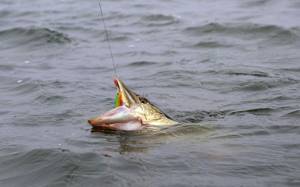
When choosing a leash, the angler should focus on the goals and objectives of the upcoming fishing. The relevance of the choice is undeniable, but often the fisherman has to face the problem: what is more important is the invisibility of the leash or its strength, the cheapness of the leash as a consumable material or its reliability.
When fishing for pike, the scales, as a rule, tip in favor of metal leashes , although they are noticeable, the possible loss of bait, and with them the prey, leaves no doubt about the correctness of such a choice. Both thick monofilament and fluorocarbon can resist pike teeth, but attaching fittings to them without using crimping tubes is quite difficult.
At the same time, not only the material from which the leash is made, but also its durability, resistance to external influences, as well as such characteristics as length and breaking load can have a huge impact on the final result.
When catching cautious fish (except pike), the determining factor may be the visibility of the leader in the water , and here the use of fluorocarbon will be optimal.
As you know, the braided line that most spinning anglers now use to fish has low abrasion resistance. Therefore, when fishing in places where the final section of the main line, to which the bait is directly attached, has to constantly come into contact with various obstacles, a wear-resistant leash is installed between the main line and the bait, which can be made of fluorocarbon, monofilament, or even metal, if this is not critical for the bite.
Main characteristics of leashes
- Leash strength (Breaking load).
One of the most important characteristics. The breaking load of the leads used is, as a rule, much higher than that of the main line. This parameter is indicated on the manufacturer's packaging. For homemade leashes made of steel wire, etc. this parameter is determined experimentally. - Flexibility (plasticity).
In order for the bait to work well, it is important that the leash is flexible. This is especially important when fishing with small and light baits. When trolling, fairly large baits are used and the flexibility of the leash is not so important. - Leash color.
Depending on the type of fabric and the manufacturing company, leashes are available in silver, green and black. The most universal, from our point of view, is a dark green canvas. - Lead diameter (web diameter).
On the one hand, the larger the diameter of the blade, the higher the breaking load parameter. On the other hand, the thicker the canvas, the worse your bait will work - the more it will alert the fish. Residual memory. Many leashes become deformed after use under stress. When the leash is deformed, the cord may become “tangled” and the axis may change during wiring. When using heavy baits, this parameter is not so significant. - Resistance to chafing and cutting/biting
is the main parameter that should be given importance, since this is the main task of the leash. The length of the leash depends on the method and place of fishing.
When catching peaceful fish
A leash for a fishing rod with float equipment or for mounting in feeder fishing increases the sensitivity of the gear. A peaceful fish, not showing aggressiveness due to its natural caution and constant heightened suspicion in any moments that cause concern, will ignore even the most attractive bait. Only inconspicuous equipment can reduce the risks of this phenomenon and force the fish to bite, not the least of which is played by a properly selected leash. Next, we will justify the use of leash elements, depending on the type of peaceful fishing, focusing on the selection of optimal accessory materials, their basic geometric parameters and properties.
Instructions for fishing with a float rod

The leash on the fishing rod is placed between the sinkers and the hook, attached to the main fishing line. Its role is to ensure the inconspicuous supply of bait, as well as to protect the main cord of the tackle with a float and weight from breaking and irretrievable loss, which can occur under two conditions - getting caught on any obstacles in the water or biting a trophy that can crush the tackle. As a rule, in the assembly of float installations, monofilament leads are used, the breaking load of which, as well as their diameter, is an order of magnitude less than the parameters of the main fishing line. Leashes are thinner than the base, and when selecting an accessory in the color of the water or bottom base, they are much more invisible than the main cord. The length of the leashes varies depending on the activity of the fish and the fishing conditions.
Important! It is worth noting that the longer the leash, the lower the information content of the bite, but at the same time, the equipment is less alarming to the fish.
Thus, when the fish is highly active, short leashes in sizes from 10 to 25 cm are used. If the fish is passive, the bites are unstable and not expressive, the length of the leash element is increased, and it can vary from 2 to 50 cm, and in some cases and higher.
Features of use when fishing on a feeder
In feeder fishing, the role of leashes is identical to the role of an accessory in float rigs. It’s just that fishermen, often using monofilament leash elements, also include leashes made from braided lines in their feeder rigs. Bottom fishing, and in particular feeder fishing, differs from float fishing in more stringent fishing conditions associated with laying equipment and bait on the bottom of the reservoir, which differs in structural structure, and much larger trophies are expected in the catches. Therefore, leashes must provide both reliability and at the same time inconspicuousness.
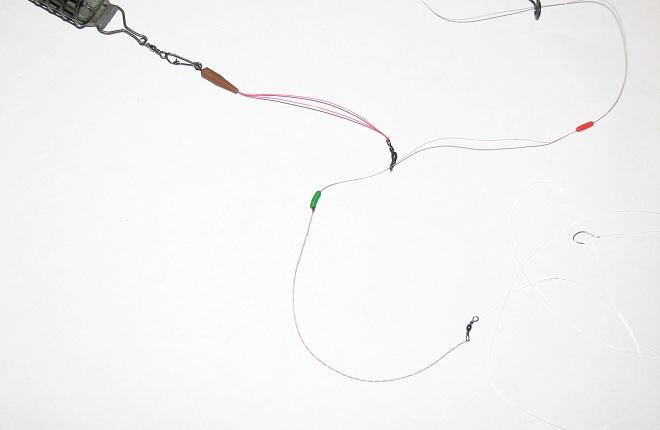
Reliability on pebble, shell and rocky surfaces is ensured by monofilament, which is less susceptible to abrasion. Fishing on muddy bottoms and strong currents is easier to do with the use of soft braided leashes that can withstand enormous forces from the resistance of the trophy. The length of the leashes also depends on the activity of the fish, but in feeder fishing the leash sizes are higher than on float rigs and in some cases, when fishing on currents, the leashes can reach one and a half or even two meters in size.
Important points
The important points of using leader material in catching peaceful fish include the fact that the fisherman is quite capable of producing all these accessories independently from standard fishing lines, having only the skills to make special fishing knots. You can make a leash for a fishing rod or a feeder installation in advance at home, thus providing a certain supply in various diameters and sizes of the accessory for planned fishing trips. Subsequently, in real fishing conditions, all that remains is to select the optimal leash options and fish comfortably. To ensure a quick change of equipment, miniature fasteners or carabiners are placed on the main cords, and the leashes themselves are made with self-tightening loops. In addition to selecting the diameters and lengths of leashes, they are knitted with hooks of different sizes, giving the opportunity to experiment with baits.
Making leashes
Making leashes There is an opinion among fishermen that leashes need to be tied annually.
There are people who do this, for example, when they go to a resort with their family, because lying on the beach gets boring already on the second day. But not everyone has the opportunity to devote a considerable number of days only to knitting leashes. Experience shows that if the leash is tied well, has not been used for fishing and has not been stored in dampness or sunlight, then it practically does not lose its strength, which means it does not require tying. As necessary, it is worth preparing leashes to replace used ones or knitting new ones for other fishing conditions. This saves a lot of time, and the range gradually becomes so extensive that you can choose any, sometimes even unimaginable, combination of fishing line and hook. To make quality leashes, you should learn how to knit a couple of knots to tie a loop and tie a hook. To ensure that the length of the leashes is the same, before tying the loop, the length of the leash is measured using a ruler or pre-made marks. The knot with which the loop is tied must be moistened before tightening so as not to burn the fishing line. Long winter evenings are just the time when you can provide yourself with a supply of leashes for the upcoming season of float or feeder fishing.
When making leashes, you must follow the following rules:
- In terms of its strength, the leash must certainly be weaker than the line to which it is tied.
- To catch predatory fish, the leash must be made of such material that the predator cannot bite it and so that the leash does not break due to a sharp and sharp bend.
Characteristics
The characteristics and types of leashes depend on the fish to be caught. In the case of peaceful ones, certain requirements are imposed on them, while for use on a predator – different ones. There are also criteria that are universal.
Material
The main criterion for a fishing leash is choosing the right material. This is decisive depending on your gear and the fish you are hunting.
Most often used for peaceful fish:
- nylon fishing lines;
- braids;
- leadcore;
- fluorocarbon.
To catch a predator use:
- fluorocarbon;
- hard monofilament;
- Kevlar;
- steel;
- titanium;
- tungsten;
- leash materials.
Let's take a closer look at the advantages and disadvantages of leashes made from the listed materials, as well as cases of their use.
Nylon
Ordinary nylon fishing line is most often used in the manufacture of leashes for peaceful fish. The monofilament can be floating, sinking or neutral in buoyancy. Depending on this, you can choose the best option for specific fishing conditions.
Attention! When choosing a material, keep in mind that it is optimal when the leader line is 0.02 millimeters thinner than the base.
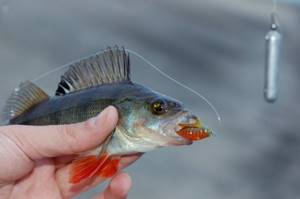
For Moscow spinning equipment, thick monofilament fishing line is also often used.
Braided fishing line
Thin braided line is perfect for carp hair rigs. Due to its softness, it can be used with various boilies, both floating and sinking.
Leadcore
And just like the previous option, it is used mainly in carp fishing. This is a piece of lead wire in a soft braid. Its main advantage is its relative heaviness, which allows it to hold the bait at the bottom of the reservoir.
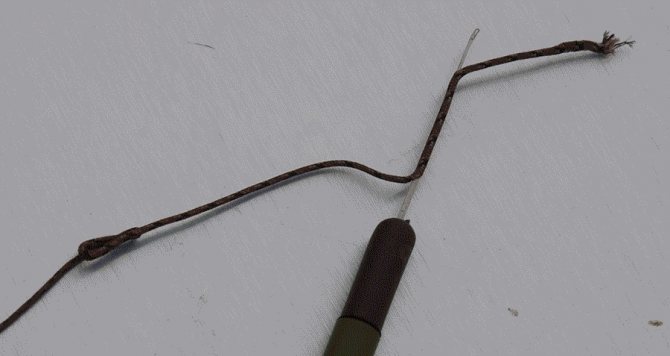
Inside the soft braid of the leadcore is a lead core.
Fluorocarbon
The material made from the compound fluorocarbon line for leashes is used in two cases:
- Thin diameters to create invisible equipment. The refractive index of the material is close to that of water.
- Thick fluorocarbon lines have sufficient rigidity for use in a variety of spaced-out spinning equipment:
- Moscow;
- drop shot;
- Caroline
Important! With the same diameter as nylon fishing line, fluorocarbon has a significantly lower breaking load!
Kevlar
This modern, durable material is used by predatory fish hunters using live bait gear or spinning rods. Kevlar threads are woven into a kind of braid. Its advantage is that it is cheap and that leashes can be knitted simply like regular fishing line. The disadvantage is its high visibility in the water and the fact that it is not always able to withstand the attack of pike teeth.
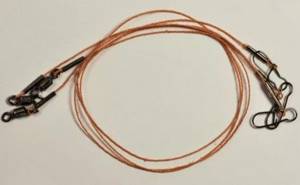
Kevlar leashes are one of the market leaders in terms of cheapness.
Leash storage
Storing leashes When storing leashes while fishing, you need to pay due attention so that they are always at hand if you need to replace a broken one or when a fish swallows a hook deeply, so that you can later remove it from the fish without interference.
For quick replacement, a loop-to-loop fastening method is usually used and replacement usually takes no more than a few seconds. And in order not to bother knitting leashes on a pond, wasting precious time, they are usually knitted at home in a calm environment.
They are stored while fishing in different ways. You can store them on a reel made of polystyrene foam or plywood, but they don’t always hold up well this way, and they curl into rings.
The best way is to take a duralumin or plastic tube approximately equal to the size of the leash. A rubber ring is put on one end of the tube, which should fit tightly around the tube. The hooks are hooked onto the edge of the other end of the tube, and the other end of the leash is placed under the elastic band. In this case, the leads are always straight, and the tips of the hooks are hidden inside the tube and do not catch on anything.
How to bind?
“Loop to Loop”
The connection between the leash and the fishing line should be simple and at the same time strong , since, as is known, the strength of the fishing line in water decreases by about 15-20%; the simplest and most common fastening method is the “loop-to-loop” method.
This method is universal for all types of materials from fluorocarbon fishing line to field cable core. It is possible to use a running knot or a figure eight knot.
Another type of leash attachment is the universal Palomar knot , with which you can attach not only the leash, but also bait, fishing line and cords.
A distinctive feature of such a knot is that the strength of the connection is approximately 85-90% of the strength of the fishing line.
Palomar knot:
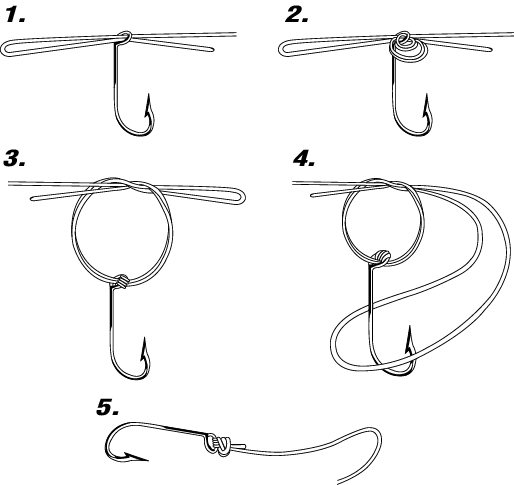
Making a leash from a guitar string with your own hands
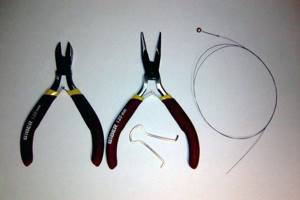
In the simplest case, nothing other than the string itself is required to make a leash. If the angler does not want to unwind and re-twist the string every time he changes the bait, he will also need fasteners, and if he is afraid that the string may cut the cord, then swivels. To make a string leash you will need the following tools:
- wire cutters;
- vice;
- pliers;
- nail or tube with a diameter of 2 mm.
A leash is made from a string as follows:
- Bite off a piece of string of the required length.
- Bend one end parallel to the entire segment.
- Clamp the bend in a vice and twist it with your hands or pliers.
- The twist is done in the same way on the other side.
Either: insert a nail or tube into the bend and twist it with your hands or pliers;
If you plan to equip the leash with a swivel and a clasp, then they are put on the bend before twisting. Sometimes a cambric is put on top of the twist, which prevents the string from unwinding.
Fluorocarbon leader
Its distinctive feature is that its refractive index of light is almost the same as that of water. This equipment causes a lot of controversy in the fishing community. It is believed that such a leash can compete with steel in strength, while it is transparent and, for the most part, invisible to the fish.
Others believe that when catching predators such as pike, its use is pointless, because the pike will easily bite it and jump off the hook.
It is believed that it acquires the required degree of rigidity only when its thickness exceeds 0.5 millimeters. The use of a fluorocarbon leash has become most popular when using light baits on those fish that are unable to chew through it (this applies, for example, to perch).
Reviews for fluorocarbon leash
— I use steel leashes only when fishing for pike. But most often I catch perch with a spinning rod, but when fishing for perch there is always the opportunity to catch a bee-eater, so I always use leashes, but usually still fluorocarbon, 0.16-0.2 thick and from 40 cm to 150 cm long. Steel leaders reduce the quantity very much. For example: I spent the entire last season rinsing the Sura with spinners, spoons, jigs, and wobblers, but I didn’t see a single bite. Only once did I catch a gudgeon by the gills. This year I replaced the steel leashes with fluriks. On the first fishing trip the result was three perches.
— Under certain conditions, there were clearly defined situations when a fluorocarbon leash defeated other leashes with a devastating score. It is undesirable to use thin diameters when fishing for pike; several of my “Japanese” teeth were chewed off last year, but the total number of bites was higher than that of my comrades.
Which to choose
Store
When choosing a leash in a fishing store, it all depends on what kind of fish to catch and in what conditions you will be fishing. If a leash is a consumable item when fishing with silicone baits in places rich in hooks, you should give preference to cheap leashes . These can be Chinese braided leashes or factory string leashes. You should know that Chinese leashes have low quality fittings, so if possible, it is better to replace the fasteners with more reliable ones.
Tungsten leashes are also low cost, but are essentially disposable. If you plan to use the leash for a long time, then the optimal choice would be multi-strand steel leashes or those made of titanium. Factory-made fluorocarbon leaders free the angler from unnecessary work, but have a fairly high price.
Expert opinion
Knipovich Nikolai Mikhailovich
Zoologist, hydrobiologist. I am interested in fishing at a professional level.
Important! When choosing a leash in a store, an angler should pay attention to the quality of workmanship. The leash must be even along its entire length and free from burrs. It is better to buy leashes from trusted manufacturers.
Homemade
a homemade leash from a guitar string , its price will be ridiculous, and although it is very short-lived, it is quite suitable for many anglers as a consumable material. In addition, it has additional positive qualities: it has light weight and rigidity, which is necessary when fishing with wobblers by twitching.
Metal leashes made from factory-made leash material will require some effort to make, but will cost less than exactly the same ready-made ones. It is also better to make fluorocarbon leaders yourself.
